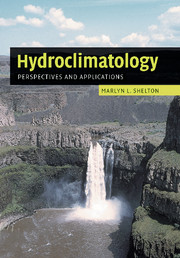Book contents
- Frontmatter
- Contents
- Preface
- 1 The realm of hydroclimatology
- 2 The climate system and the hydrologic cycle
- 3 Measuring hydroclimate atmospheric components
- 4 Measuring hydroclimate terrestrial components
- 5 Remote sensing and hydroclimate data
- 6 The runoff process and streamflow
- 7 Hydroclimate spatial variations
- 8 Hydroclimate temporal variations
- 9 Floods: the hydroclimatic extreme of excessive moisture
- 10 Drought: the hydroclimatic extreme of deficient moisture
- References
- Index
2 - The climate system and the hydrologic cycle
Published online by Cambridge University Press: 06 July 2010
- Frontmatter
- Contents
- Preface
- 1 The realm of hydroclimatology
- 2 The climate system and the hydrologic cycle
- 3 Measuring hydroclimate atmospheric components
- 4 Measuring hydroclimate terrestrial components
- 5 Remote sensing and hydroclimate data
- 6 The runoff process and streamflow
- 7 Hydroclimate spatial variations
- 8 Hydroclimate temporal variations
- 9 Floods: the hydroclimatic extreme of excessive moisture
- 10 Drought: the hydroclimatic extreme of deficient moisture
- References
- Index
Summary
Climate and water
Climate variability directly impacts the water resource and has stimulated expanding interest in the scientific study of the global hydrologic cycle. Water is a fundamental aspect of most people's lives in humid regions where its supply is taken for granted, but water is highly valued in supply-limited arid regions. The prospect of climate change and an altered water supply imposes a broadened dimension for everyone to understand the relationships among climate, the hydrologic cycle, and the water resource. In addition, water's role in geochemical and biological processes involving climate and landscape change is receiving increased attention. Although the hydrologic cycle displays large annual, seasonal, and regional variations, large-scale modifications of the Earth's surface due to human activity affect the water balance of the continents and of the atmosphere and oceans. Numerical simulations suggest that water vapor in the atmosphere significantly amplifies enhancement of the greenhouse effect with ramifications for altering the climate system (Burroughs, 2001). Against this backdrop, understanding the relationship between the climate system and the hydrologic cycle assumes a high priority.
The conceptual development of hydroclimatology recognizes that climate is the driving force for the hydrologic cycle. Interactions of precipitation, evapotranspiration, interception, percolation, soil moisture storage, groundwater recharge, other surface and near-surface water relations, and streamflow are all hydroclimatology components. Consequently, hydroclimatology provides a perspective for analyzing a broad range of water resource problems involving current and future states of the climatic and hydrologic systems.
- Type
- Chapter
- Information
- HydroclimatologyPerspectives and Applications, pp. 24 - 54Publisher: Cambridge University PressPrint publication year: 2008



